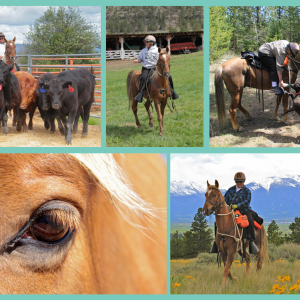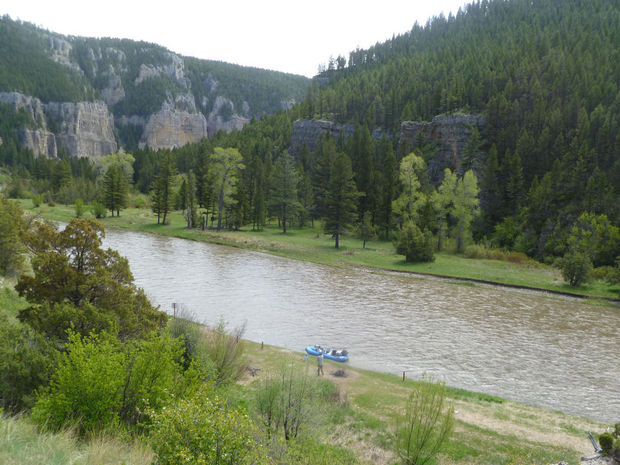 SuzAnne Miller is the owner of Dunrovin Ranch. A fourth-generation Montanan, SuzAnne grew up roaming the mountains and fishing the streams of western Montana. Her love of nature, animals, science, and education prompted her to create the world’s first cyber ranch where live web cameras bring Dunrovin’s wildlife and ranch life to internet users across the globe.
SuzAnne Miller is the owner of Dunrovin Ranch. A fourth-generation Montanan, SuzAnne grew up roaming the mountains and fishing the streams of western Montana. Her love of nature, animals, science, and education prompted her to create the world’s first cyber ranch where live web cameras bring Dunrovin’s wildlife and ranch life to internet users across the globe.
Visit SuzAnne live at www.DaysAtDunrovin.com!
Chinook came to Dunrovin under difficult circumstances. Power, SuzAnne’s beloved partner for over 15 years, suddenly died and left SuzAnne with a broken heart and in need of a new guide horse to lead horseback trips into the back country. While most of the horses from the Dunrovin remuda could have fit the bill, SuzAnne didn’t want to take any one of them out of commission for guests, so she started the long process of finding a new horse. However, she had a problem: while riding one of her horses in the arena, it fell on top of SuzAnne and badly injured her leg. This meant that not only was she without a lead horse, she was out of the saddle all together. She would have to enlist assistance from her many friends in Montana’s horse world to not only find the right horse, but to “test drive” it for her.
The word went out and soon a horse in Bozeman, Montana rose to the top of the list. With her good friend, Coe, along to do the riding, SuzAnne went to Bozeman to meet the horse. He impressed both SuzAnne and Coe, so she brought him home for a test period. His beautiful, fast gait and he sweet personality won SuzAnne’s heart in no time.
He had a great deal to learn to become a lead horse Dunrovin ranch. That first summer did not go smoothly as he was literally thrust into situations for which he was not totally prepared: he was young and vigorous, but he ran from cattle, he spooked at all manner of wildlife, he lacked the conditioning to negotiate the difficult terrain, and he really didn’t know how to control or balance his body when facing obstacles. But he gave it his all. After each fall or stumble, both he and SuzAnne got up and tried harder.
Once the summer season was over, SuzAnne had more time to dedicate to just him and his needs. They spend lots of quality time together learning to trust and enjoy each other’s company and building his physical strength and conditioning. He spent a couple of weeks at a cattle ranch getting accustomed to being around them. SuzAnne took time to just play with him so that every encounter between them was not focused on work or training. It worked! He is an excellent lead horse with a very warm personality and lots of go. SuzAnne began to occasionally allow other members of the Dunrovin staff to use him as a lead horse – and they quickly saw his many merits and now request him whenever they can.
His name had been Jazzy when SuzAnne bought him – a name that did not resonate with her. Mulling over possibilities, it was Sterling who suggested Chinook – a warm breeze during the winter of SuzAnne’s grief over Power. It has proven to be the perfect name. He did, indeed, breath new, fresh air into SuzAnne’s life after losing Power. Chinook has captured not only SuzAnne’s heart and admiration, but Dunrovin staff as well. They love riding him on those few occasions when SuzAnne is willing to let him go.
 It's one of the building blocks of life. A resource that's bountiful in western Montana -- in our lakes and waterways, and underground. Our water, according to Professor Steven Running, is what could become the state's biggest draw.
It's one of the building blocks of life. A resource that's bountiful in western Montana -- in our lakes and waterways, and underground. Our water, according to Professor Steven Running, is what could become the state's biggest draw.

 When you think of Yellowstone National Park, grizzly bears probably come to mind. Researchers are gearing up for a study looking at the trends of this bear population that has become quite the attraction.
When you think of Yellowstone National Park, grizzly bears probably come to mind. Researchers are gearing up for a study looking at the trends of this bear population that has become quite the attraction. Central Montana’s pristine Smith River has been named among the most-endangered rivers in the nation by environmental advocacy group American Rivers, which cites the threat posed by a Tintina Resources copper mine proposed near one of the river’s tributaries.
Central Montana’s pristine Smith River has been named among the most-endangered rivers in the nation by environmental advocacy group American Rivers, which cites the threat posed by a Tintina Resources copper mine proposed near one of the river’s tributaries.